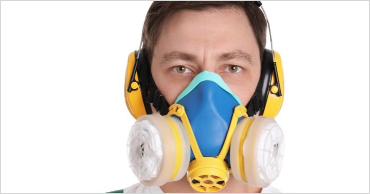N95 respirators and toxic gases or vapors
There is a common misunderstanding in health care that the N95 respirator can protect workers from gases and vapors. This is completely false. The N95 offers no protection from exposure to any chemical odors, gases or vapors that one would typically experience in a hospital or health care setting.
N95 respirators use a filter of densely woven fibers that can stop aerosol particles through impaction, interception and diffusion as the air being breathed in passes the mesh. They are 95 percent efficient in stopping particles down to about 0.1 micrometers (microns) in diameter. So they work well on tuberculosis, and other bacteria, that range in size from about 0.3 to 20 microns.
Gas molecules, however, range in size from only 0.0003 – 0.006 microns. As a result, gases like oxygen, chlorine, hydrogen sulfide and ammonia can all pass freely in the spaces between the fibers in an N95 mask.
The recommendation to use an N95 respirator to reduce the impact of a chemical gas exposure is comparable to the use of a placebo in patient care. Any improvements in conditions are only perceived and are not real.
In order to remove gases from the air they must be either absorbed or adsorbed by a filter media. Absorption occurs when a gas or vapor penetrates a solid structure (like charcoal) and gets “trapped” in the constituent molecules, atoms and ions of the structure. Adsorption is a phenomenon where the gas or vapor interacts with the outer surface of a solid structure through either van der Walls attraction or a combination of chemical interactions.
Workers in different industries are exposed to thousands of different airborne agents. The selection of the appropriate respirator for the hazardous airborne agent is a complex process and should only be done by a qualified industrial hygienist who thoroughly understands the toxic properties of the agents, the workplace levels and safe or regulatory limits of exposure, and the protective capabilities of the respirator.
Any employer with hazardous airborne working conditions is required by the Occupational Safety and Health Administration (OSHA) to have a written respiratory protection program. The program requires that only knowledgeable and competent professionals implement the program, to include assessment of the specific hazards, selection of the respirator appropriate to protect the workers, medical clearance, fit-testing, and worker training. Just like only certain glove materials are protective for only certain chemicals, respirators must be selected in accordance with the airborne hazards and concentrations in the workplace. And just like physicians and nurses have the responsibility to prescribe and administer medicines safely and competently, industrial hygienists have the responsibility to assess workplace exposures and specify appropriate respiratory protection.
Originally published Massachusetts Nurse Newsletter, September 2008 by Thomas Fuller, ScD, CIH




